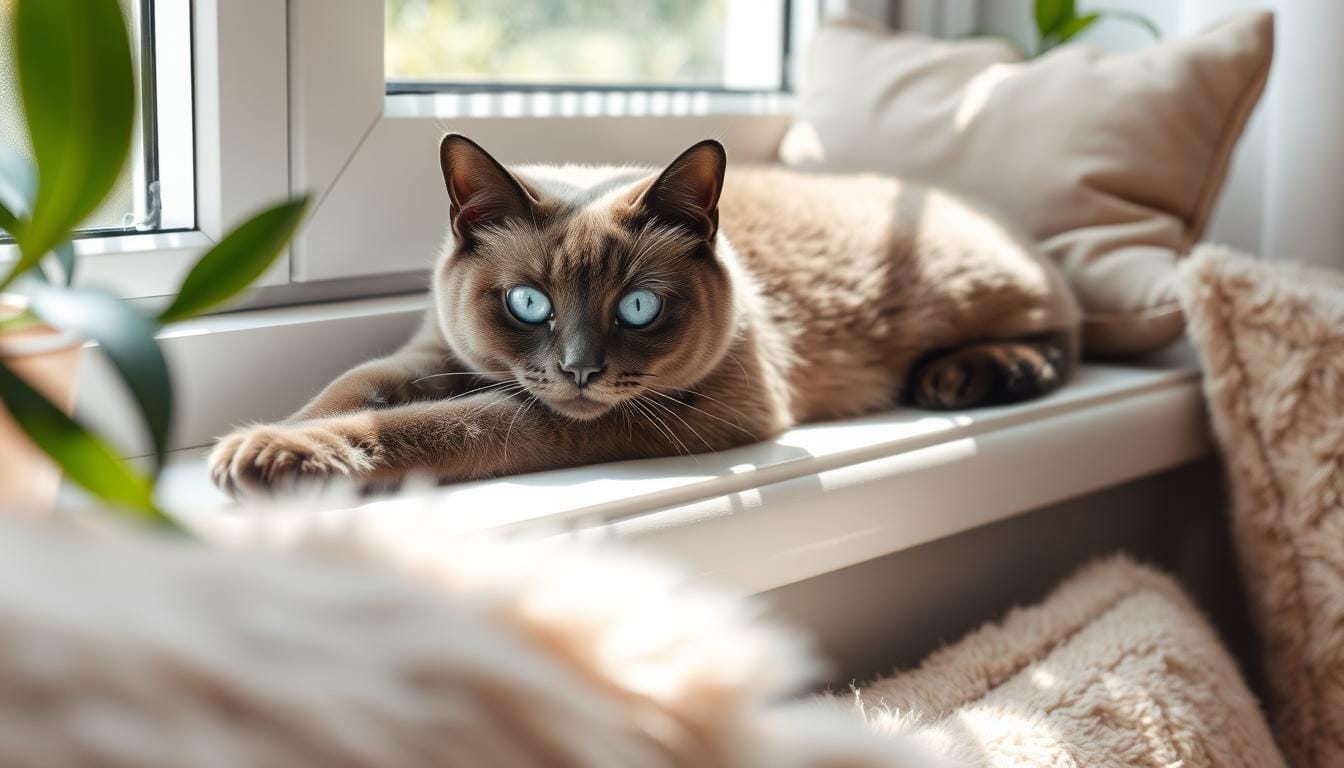Get ready to fall in love with grey Siamese cats! These cats are a special version of the Siamese breed. They have a unique blue-point color that makes them stand out. This guide will share interesting facts about grey Siamese cats, from their origins to their care needs.
The grey Siamese comes from the rich history of Siamese cats. Their grey shades and smart, loving nature make them amazing. If you love cats or just want to learn more, this guide will show you why grey Siamese cats are special.
- Understanding the Grey Siamese Cat Breed
- The Distinctive Blue-Point Coloration Pattern
- Grey Siamese: Temperament and Personality Traits
- Health Considerations for Your Grey Siamese
- Grooming and Care Requirements
- Traditional vs Modern Grey Siamese Features
- Common Misconceptions About Grey Siamese Cats
- Choosing and Adopting Your Grey Siamese
- Conclusion
- FAQ:
- What is a grey Siamese cat called?
- What color Siamese is rare?
- What is the genetic mutation in Siamese cats?
- What breed is a blue grey cat?
- Why do Siamese cats turn dark?
- What is the origin of the grey Siamese cat?
- How do grey Siamese cats differ in appearance from other Siamese varieties?
- What are the personality traits of grey Siamese cats?
- Are there any common health concerns for grey Siamese cats?
- Where can I find a grey Siamese cat for adoption or purchase?
Understanding the Grey Siamese Cat Breed
The thai cat has a rich history. It started as the traditional siamese and evolved into the modern siamese. These cats come from Thailand, once called Siam. They have won the hearts of many pet lovers around the world.
Origins and Historical Background
The thai cat, or traditional siamese, comes from ancient Siam, now Thailand. They were loved by the Thai royal family. Their special looks and personalities made them sacred in the palace.
Breed Recognition and Standards
The traditional siamese became known worldwide. Cat groups set standards to keep their unique traits. The modern siamese is now recognized by groups like the Cat Fanciers’ Association (CFA) and The International Cat Association (TICA).
Physical Characteristics Overview
- Sleek, muscular body with a distinctive wedge-shaped head
- Elegant, long limbs and a well-proportioned, graceful build
- Vibrant, piercing blue eyes that captivate attention
- Distinctive “point” coloration, with darker shades on the extremities and a lighter body
| Trait | Traditional Siamese | Modern Siamese |
|---|---|---|
| Body Type | Muscular and athletic | Slender and refined |
| Head Shape | Broad, wedge-shaped | Narrow, wedge-shaped |
| Coat Texture | Short, fine, and silky | Short, fine, and glossy |
| Eye Shape | Almond-shaped | Slightly more rounded |
The Distinctive Blue-Point Coloration Pattern
The grey Siamese cat’s blue-point coloration comes from a special genetic trait. This trait, called temperature-sensitive albinism, lets these cats start white and then get darker points. These points show up on their ears, face, legs, and tail as they grow older.
This unique look is thanks to the Cb or chinchilla gene. It stops pigment from showing up in the warmer parts of the body. So, the cat’s body stays pale, while the points get darker. This creates the famous blue-tinged look that makes the grey Siamese stand out.
| Characteristic | Description |
|---|---|
| Coat Color | The grey Siamese cat’s coat is a mix of pale, icy grey and deeper charcoal tones that concentrate on the points. |
| Eye Color | These cats are renowned for their piercing, blue-eyed gaze, a result of their temperature-sensitive pigmentation. |
| Point Darkening | As the cat matures, the points on their ears, face, legs, and tail gradually darken, creating a striking contrast with the lighter body cat coats. |
The grey Siamese’s blue-point coloration is a marvel of feline genetics. It shows the amazing variety of cat coats in the world of cats.
“The grey Siamese cat’s distinctive blue-point coloration is a result of a fascinating genetic adaptation that allows their pigment to be temperature-sensitive.”
Grey Siamese: Temperament and Personality Traits
Grey Siamese cats are known for their intelligence, vocal nature, and strong bond with humans. They have unique personality traits that set them apart from other cats.
Social Behavior Patterns
Grey Siamese cats love to be around people and enjoy constant interaction. They form deep bonds with their owners, often following them everywhere. These cats have a wide range of sounds, including meows, chirps, and a special “Siamese yowl” to communicate.
Intelligence and Training Potential
The Siamese cat is known for its intelligence, and the grey Siamese is no different. They are easy to train with positive reinforcement and mental challenges. With patience, they can learn tricks and commands, making them fun to be around.
Interaction with Family Members
- Grey Siamese cats bond well with everyone in the family, including kids.
- They love attention and affection, always looking for cuddles and playtime.
- These feline breeds can be protective of their family, alerting them to any danger.
Grey Siamese cats are intelligent, social, and loving. They make great companions for families looking for a lively and engaging pet.
Health Considerations for Your Grey Siamese
As a proud owner of a grey siamese cat, it’s key to know about health issues. Siamese cats are usually healthy, but they can face certain genetic problems. These need early care and watchful eyes.
Grey siamese cats often get respiratory issues like asthma and bronchial problems. These can be managed with the right meds and changes in their environment. It’s vital to work with your vet to keep your cat healthy.
Also, grey siamese cats might get dental issues like gingivitis and periodontal disease. Regular dental checks and cleanings, plus home care, can help. This keeps your cat’s mouth in good shape.
It’s also important to feed them right and keep them active and mentally stimulated. Your vet can help with the best diet and exercise for your pet.
By knowing about grey siamese health issues and acting early, you can help your cat live a long, happy life. This is with you by their side.

Don’t forget, regular vet visits are key to keeping your grey siamese healthy. With the right care, your grey siamese can be a joy to your family.
Grooming and Care Requirements
Keeping a grey Siamese cat’s coat silky takes some effort, but it’s worth it. These cats need regular grooming to look their best. Their cat coats and oriental shorthair features shine with the right care.
Coat Maintenance Tips
Brush your grey Siamese’s coat twice a week to avoid tangles. Use a soft-bristle brush or a rubber glove to spread their natural oils. Bathe them every 4-6 weeks with a gentle, cat-safe shampoo to keep their skin and coat healthy.
Dietary Needs and Preferences
Your grey Siamese needs a high-quality diet rich in protein. This gives them the energy for play. Choose cat food made for oriental shorthair breeds, as it has more protein and less carbs.
Exercise and Environmental Enrichment
- Give your grey Siamese lots of chances to play with toys, climb, and run.
- Use puzzle toys to keep their minds sharp and their hunting instincts alive.
- Make sure they have a safe, interesting place to live with scratching posts and hiding spots.
Meeting your grey Siamese’s grooming, diet, and play needs will help them live a happy, healthy life with you.
| Grooming Frequency | Dietary Considerations | Exercise Needs |
|---|---|---|
| Brush 2-3 times per week Bathe every 4-6 weeks | Protein-rich diet Formulated for oriental shorthair breeds | Interactive toys Puzzle feeders Vertical perches |
Traditional vs Modern Grey Siamese Features
The grey Siamese cat has changed a lot over the years. From the old traditional Siamese to the new modern ones, their looks have changed a lot. This change shows how cat breeding has evolved over time.
The traditional siamese is known for its sleek, athletic body. It has a long, slender shape and a wedge-shaped head. They also have big, expressive ears and a pointed muzzle, making them look regal and elegant.
On the other hand, the modern siamese is more sturdy and has a rounded head. Their face is broader than the traditional Siamese.
| Trait | Traditional Siamese | Modern Siamese |
|---|---|---|
| Body Shape | Slender and athletic | Compact and muscular |
| Head Shape | Wedge-shaped | Rounded |
| Facial Features | Pointed muzzle, large ears | Broader face, smaller ears |
| Overall Appearance | Elegant and regal | Stockier and more muscular |
The physical changes in Siamese cats come from selective breeding. Breeders have focused on different looks, creating these two types. Knowing these differences helps people understand the special qualities of both the traditional and modern grey siamese cats.

Common Misconceptions About Grey Siamese Cats
There are many myths about grey siamese cats. Let’s clear up some of these wrong ideas. This will help you understand this amazing cat breed better.
Color Variations and Genetics
Many think grey siamese cats are rare. But, the grey siamese color, or blue-point, is just one of the Siamese breed’s accepted colors. It comes from certain genes that affect the cat’s color.
Behavioral Myths Debunked
Some believe siamese cats are mean or hard to train. But, this is not true. Siamese cats are loving, smart, and easy to train. With the right care, they become great, loyal friends.
It’s also a myth that grey siamese cats are different from other Siamese cats. They have the same loving nature and want to be with their people.
By knowing the truth, you can see the real beauty of grey siamese cats. They are not only beautiful but also have a special personality. This makes them wonderful pets.
Choosing and Adopting Your Grey Siamese
Bringing a grey Siamese or Thai cat home is a big decision. It’s important to think it through carefully. These cats are special because of their looks and lively personalities. Knowing what to look for can make adopting one a great experience.
Finding a good breeder or rescue is key. They should care about the cats’ health and happiness. They can tell you a lot about the cat’s personality and if it fits your life.
- Look for well-known grey Siamese breeders and shelters near you.
- Go to cat shows or events to meet grey Siamese cats and talk to owners.
- Ask lots of questions about the cat’s personality, needs, and health.
After picking the right grey Siamese, get your home ready. Make sure it’s safe and fun for your new cat. Provide the right food, grooming, and playtime.
“Adopting a grey Siamese cat is a rewarding experience, but it requires a commitment to their unique needs and preferences. With the right preparation and care, you can create a lifelong bond with your feline companion.”
By following these tips and understanding the grey Siamese breed, you’ll be ready to give your new cat a loving home.
Conclusion
The grey Siamese cat is a captivating breed with a rich history. They have distinctive features and a personality that brings joy. These cats are intelligent, social, and affectionate, making them great companions.
They require attentive care and grooming, but the joy they bring is worth it. If you’re interested in their striking blue-point color or their loyal nature, they’re a great choice. They make wonderful additions to any family that can give them the attention they need.
When considering a grey Siamese cat, research reputable breeders or local shelters. This ensures you provide a loving home for these unique felines. With the right care, your grey Siamese will bring endless affection and entertainment into your life.
FAQ:
What is a grey Siamese cat called?
A grey Siamese cat is commonly called a Blue Point Siamese. This elegant feline showcases soft, bluish-grey points on its ears, face, paws, and tail, paired with a pale, silvery body. Its unique coloration and refined appearance make it a captivating and sought-after variation within the Siamese breed.
What color Siamese is rare?
The rarest color in Siamese cats is the grey Siamese, often referred to as a Blue Point Siamese. Its soft, smoky grey points contrast elegantly with a lighter, silvery body. This striking and uncommon coloration results from a unique combination of genetics, making it highly sought after by enthusiasts.
What is the genetic mutation in Siamese cats?
The genetic mutation in Siamese cats affects the enzyme tyrosinase, which is temperature-sensitive. This mutation limits pigment production in warmer areas, resulting in their iconic color-point pattern. A grey Siamese showcases a diluted version of this pattern, blending genetics with environmental influences to create a uniquely soft and elegant appearance.
What breed is a blue grey cat?
A blue-grey cat often belongs to breeds like the Russian Blue, British Shorthair, or Chartreux, known for their strikingly elegant coats. Some grey Siamese cats also exhibit a bluish tint, blending their signature color points with a soft, smoky hue, creating an eye-catching and refined appearance in the feline world.
Why do Siamese cats turn dark?
Siamese cats darken due to temperature-sensitive enzymes affecting their coat color. Cooler areas of their body, like ears, paws, and tail, develop darker pigmentation, while warmer areas remain lighter. A grey Siamese may exhibit softer, smoky tones, blending genetics and temperature effects into their distinctive and elegant appearance.
What is the origin of the grey Siamese cat?
Grey Siamese cats come from Thailand. They were bred as a unique breed. They are closely related to the traditional Siamese cat, which is highly valued in Thailand.
How do grey Siamese cats differ in appearance from other Siamese varieties?
Grey Siamese cats have a special blue-point color pattern. This color comes from a genetic trait that makes their points darker while their body is lighter.
What are the personality traits of grey Siamese cats?
Grey Siamese cats are very social and talkative. They are smart, curious, and love people. They are known for being affectionate, playful, and needing lots of attention.
Are there any common health concerns for grey Siamese cats?
Grey Siamese cats might have health issues like breathing problems, dental issues, and eye problems. Taking them to the vet regularly, feeding them well, and keeping them safe can help.
Where can I find a grey Siamese cat for adoption or purchase?
To get a grey Siamese cat, find a good breeder or adoption group. They ensure the cat is healthy and well-socialized. Look at local rescues or Siamese clubs for help.

